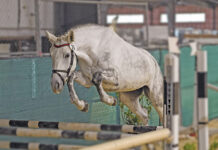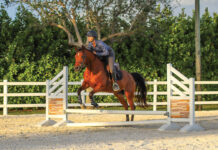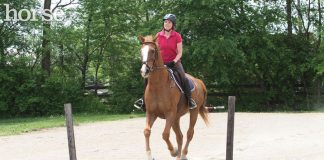No doubt about it, some horses have rough canters. This disquieting trait can be due to several reasons. Poor conformation is one. A horse that’s built higher in the hindquarters than the front end gives the rider the sensation of perpetually traveling downhill. Another is a lack of training. Fast, unbalanced horses that careen around their turns are unlikely to have smooth gaits.
 Underlying issues with unsoundness, like chronic arthritis, can also make the canter feel stilted or awkward. If have trouble staying relaxed at the canter on a horse you ride, and you’ve already addressed these potential culprits, then here are a few tips to try.
Underlying issues with unsoundness, like chronic arthritis, can also make the canter feel stilted or awkward. If have trouble staying relaxed at the canter on a horse you ride, and you’ve already addressed these potential culprits, then here are a few tips to try.- Check the length of your stirrups. Sometimes riders who are struggling to sit the canter shorten their stirrups, thinking that will give them more security. But unfortunately it has the opposite effect. Stirrups that are too short actually push the rider’s seat out of the saddle. English stirrup irons should bump your ankle bone when you sit in the saddle with your legs hanging loose against your horse’s sides. If you ride western, they should be long enough so that you merely have to tip your toe up to slide it into the stirrup, creating a slight bend in your knee.
- Can you canter without grabbing tightly on the reins—and thereby the horse’s mouth—for support? Are you confident enough to canter without holding the pommel or saddle horn (or mane) to steady yourself? If you feel insecure at the canter, and like you need to hold on to something, then you probably need to go back to the trot and work on developing an independent seat. Much like a skier or surfer, you must learn to rely on strength from your core muscles for balance.
- If you believe you canter confidently, but you start bouncing in the saddle after a few strides, then you may be trying too hard to hold yourself in place. Both English and western riders have a tendency to grip too tightly with their knees and thighs. Then their seat pops up and out of the saddle with every stride. Does this sound like you? If so, allow your entire leg to unwind. Stretch your calf muscles and sink your weight down into your heels, so you end up sitting “in” the saddle rather than “on” the saddle.
- Any amount of rigidity or stiffness in your lower back will also prevent you from sitting the canter. To help you get a feel for allowing your body to move in synch with the motion of your horse, ask one of your barn buddies or a local riding instructor to longe your horse with you on board. Make sure you tack up your horse as usual, and that he behaves on the longe line. Tie a loose knot in your reins, at a length where the knot can rest comfortably against your horse’s mane. Then, periodically while you’re being longed at the trot and canter, you can drop the reins and try holding your arms out to the side (like an airplane) or folding your arms across your chest. Such exercises allow you to develop a sense of balance and confidence in the saddle without also worrying about pace and steering.
- Riding periodically without your stirrups, regardless of whether you prefer and English or western saddle, will also help improve your seat at the canter.
If you avoid cantering because it’s scary or downright painful, don’t give up. Floating seamlessly around the arena at the canter or confidently cantering on the trails really is an obtainable goal.
See more Horsemanship How-tos >>







I have trouble not bouceing so I will try so of this help aids.
I have a tendency to stand in the stirrups while cantering. Thanks for the tips. I’m going to try to start sitting it more.
my horse always 4 beats. i can’t get her to not do that unless she goes really fast. i am working on it and she is getting better. i ride her every day.
I figured out to let my legs hang pretty loosely when cantering. I also discovered that, at least on the horse I ride, cantering bareback is easier than with a saddle!
this helps alot!! thanks! 🙂
Thanks…now i know how to correct myself.
One of my horses has a race injury so her stride has been altered which makes it hard to sit the canter. This makes me squeeze too much with my knees and my bottom pops out of the saddle. I’m going to try the tips. Thanks.
🙂 Pretty much everything my instructor told me so I know it’s great advice because I can fianlly sit my canter! No more popping out of the saddle here….for the most part anyway. 😉
This helps! I have a colt in training, and he has a b-b-b-b-b-UUUUUUUmmmmmp-p-p-p-yyyyy trot, but a ver so smooooooooooooooooooooooooth canter. My older horse, however, has a smoooooooooth trot, and a bbuummppyy canter. It helps to know what to do. Thanks, HC!
Good Artical
Very good article. I know I wasn’t very good at a canter when I first began riding, and did a lot of things wrong. But, I had the person training my horse I have now tell me to sit down like right where the back pockets are on my pants. That little trick has really helped my riding, and now I have a lot of fun cantering around.
Cool
Very good tips.
Thanks for the great tips.
These are great tips! I constantly bounce around in the saddle at the canter, and sometimes I even have to two-point! I will defenitely use these tips at my next riding lesson!
How about sitting to a bonejaring trot??
Good tips.
Great advice. I always seem to end up in 2 point. It’s more comfortable than a bouncy canter!
I cantered a lot without stirrups or rode bareback and that helped a lot!
Thanks for the article.
I have been wondering if troting a lot might make it harder to sit the canter? and I heard that a sitting trot is easier to make the transition from trot to canter and thanks for the artical
Great tip for helping to reduce rigidness! I’ve found that being relaxed helps me follow through with the motion (particularly my hip flexors http://thejodhpurscompany.com/blogs/the-jodhpurs-company-blog/19194671-how-to-canter-like-a-pro-in-five-steps ).
Thanks for the tips and another helpful article.
great info